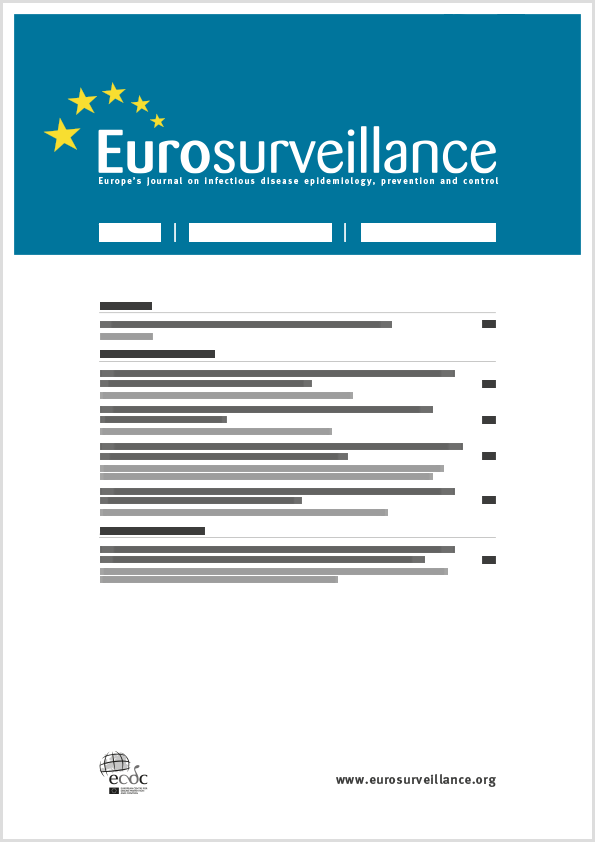- Home
- Eurosurveillance
- Previous Issues
- Volume 22, Issue 13, 30/Mar/2017
Eurosurveillance - Volume 22, Issue 13, 30 March 2017
Volume 22, Issue 13, 2017
- Editorial
- Research article
-
-
-
Significantly elevated number of human infections with H7N9 virus in Jiangsu in eastern China, October 2016 to January 2017
Xiang Huo , Liling Chen , Xian Qi , Haodi Huang , Qigang Dai , Huiyan Yu , Yu Xia , Wendong Liu , Ke Xu , Wang Ma , Jun Zhang and Changjun BaoMore LessSince first identified in 2013, the H7N9 virus has caused several waves of human infections in China, with a current wave including a number of patients with very severe disease. Jiangsu is one of the most impacted provinces, whereby as of 31 January 2017, the number of human infections (n = 109) in the ongoing fifth H7N9 wave has exceeded the sum of those in the four preceding ones. Ten of 13 cities in Jiangsu have been affected, and clustered infections as well as one co-infection with seasonal influenza have been observed. With a median age of 58 years and 74.3% (81/109) of patients being male, the characteristics of cases are similar to those in previous waves, however patients with H7N9 seem to have an accelerated disease progression. Preliminary case fatality remains above 30%. No significant viral mutations have been found in key functional loci. Environmental H7N9 detection rate and number of days with high risk ambient temperatures were both significantly elevated during the month of December 2016 when most human infections were reported. A number of municipal governments in Jiangsu have implemented live poultry market closures to impede viral transmission to humans. A detectable decline in human infections has been observed in these municipalities and the entire province since January 2017.
-
-
-
Risk factors for MERS coronavirus infection in dromedary camels in Burkina Faso, Ethiopia, and Morocco, 2015
More LessUnderstanding Middle East respiratory syndrome coronavirus (MERS-CoV) transmission in dromedary camels is important, as they consitute a source of zoonotic infection to humans. To identify risk factors for MERS-CoV infection in camels bred in diverse conditions in Burkina Faso, Ethiopia and Morocco, blood samples and nasal swabs were sampled in February–March 2015. A relatively high MERS-CoV RNA rate was detected in Ethiopia (up to 15.7%; 95% confidence interval (CI): 8.2–28.0), followed by Burkina Faso (up to 12.2%; 95% CI: 7–20.4) and Morocco (up to 7.6%; 95% CI: 1.9–26.1). The RNA detection rate was higher in camels bred for milk or meat than in camels for transport (p = 0.01) as well as in younger camels (p = 0.06). High seropositivity rates (up to 100%; 95% CI: 100–100 and 99.4%; 95% CI: 95.4–99.9) were found in Morocco and Ethiopia, followed by Burkina Faso (up to 84.6%; 95% CI: 77.2–89.9). Seropositivity rates were higher in large/medium herds (≥51 camels) than small herds (p = 0.061), in camels raised for meat or milk than for transport (p = 0.01), and in nomadic or sedentary herds than in herds with a mix of these lifestyles (p < 0.005).
-
- Top
-
- Miscellaneous
-
Volumes & issues
-
Volume 29 (2024)
-
Volume 28 (2023)
-
Volume 27 (2022)
-
Volume 26 (2021)
-
Volume 25 (2020)
-
Volume 24 (2019)
-
Volume 23 (2018)
-
Volume 22 (2017)
-
Volume 21 (2016)
-
Volume 20 (2015)
-
Volume 19 (2014)
-
Volume 18 (2013)
-
Volume 17 (2012)
-
Volume 16 (2011)
-
Volume 15 (2010)
-
Volume 14 (2009)
-
Volume 13 (2008)
-
Volume 12 (2007)
-
Volume 11 (2006)
-
Volume 10 (2005)
-
Volume 9 (2004)
-
Volume 8 (2003)
-
Volume 7 (2002)
-
Volume 6 (2001)
-
Volume 5 (2000)
-
Volume 4 (1999)
-
Volume 3 (1998)
-
Volume 2 (1997)
-
Volume 1 (1996)
-
Volume 0 (1995)
Most Read This Month

-
-
Detection of 2019 novel coronavirus (2019-nCoV) by real-time RT-PCR
Victor M Corman , Olfert Landt , Marco Kaiser , Richard Molenkamp , Adam Meijer , Daniel KW Chu , Tobias Bleicker , Sebastian Brünink , Julia Schneider , Marie Luisa Schmidt , Daphne GJC Mulders , Bart L Haagmans , Bas van der Veer , Sharon van den Brink , Lisa Wijsman , Gabriel Goderski , Jean-Louis Romette , Joanna Ellis , Maria Zambon , Malik Peiris , Herman Goossens , Chantal Reusken , Marion PG Koopmans and Christian Drosten
-
- More Less


